Business in Practice
VerifiedAdded on 2022/11/28
|9
|2580
|83
AI Summary
This report explores different practices of business, including micro, small, medium, and large businesses. It discusses the characteristics of sole trader business, partnership, limited liability business, public limited liability business, and cooperative. The report also analyzes organizational structures and their effects on business productivity. Additionally, it highlights the significance of PESTLE analysis in making informed business decisions. The case study focuses on Marks and Spencer, a British retail company.
Contribute Materials
Your contribution can guide someone’s learning journey. Share your
documents today.
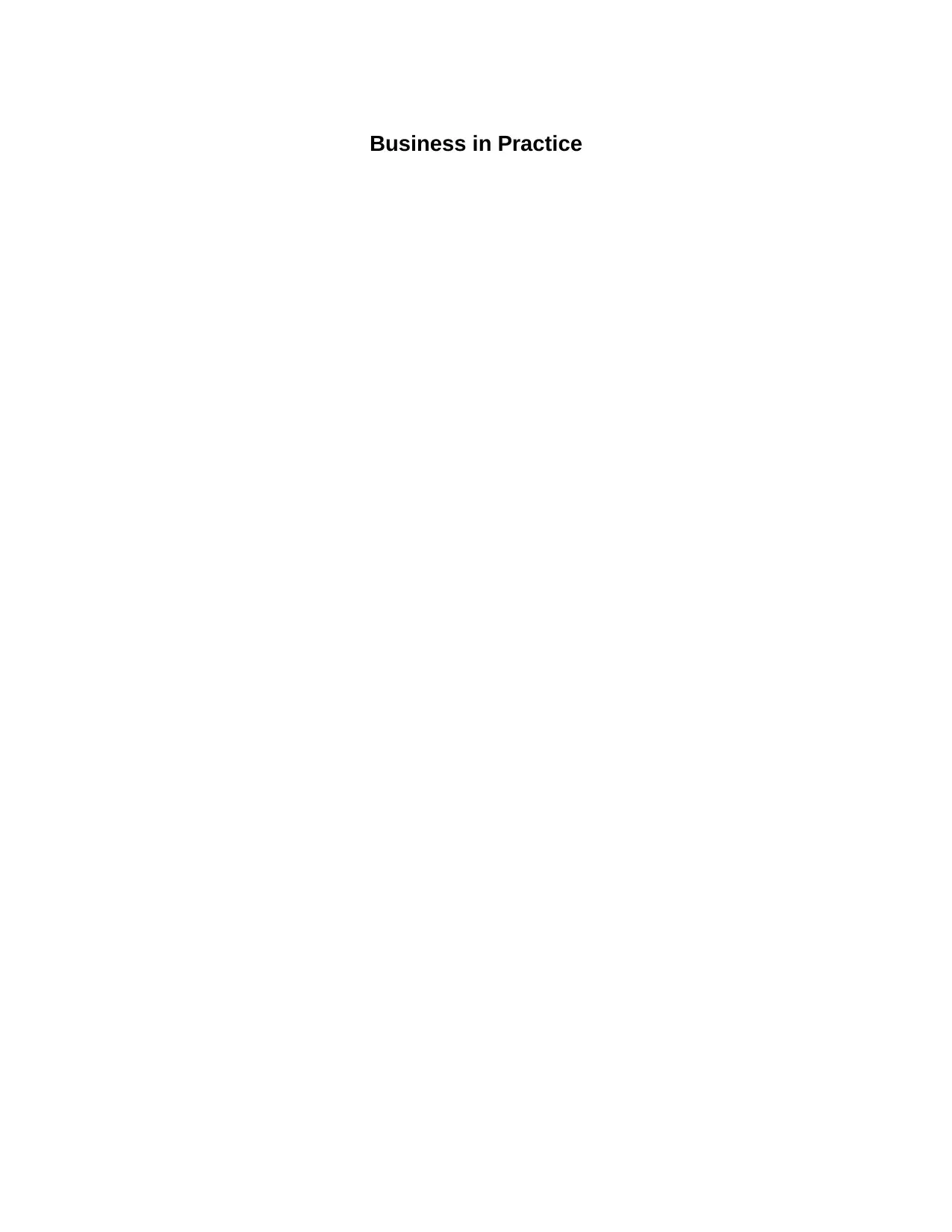
Business in Practice
Secure Best Marks with AI Grader
Need help grading? Try our AI Grader for instant feedback on your assignments.
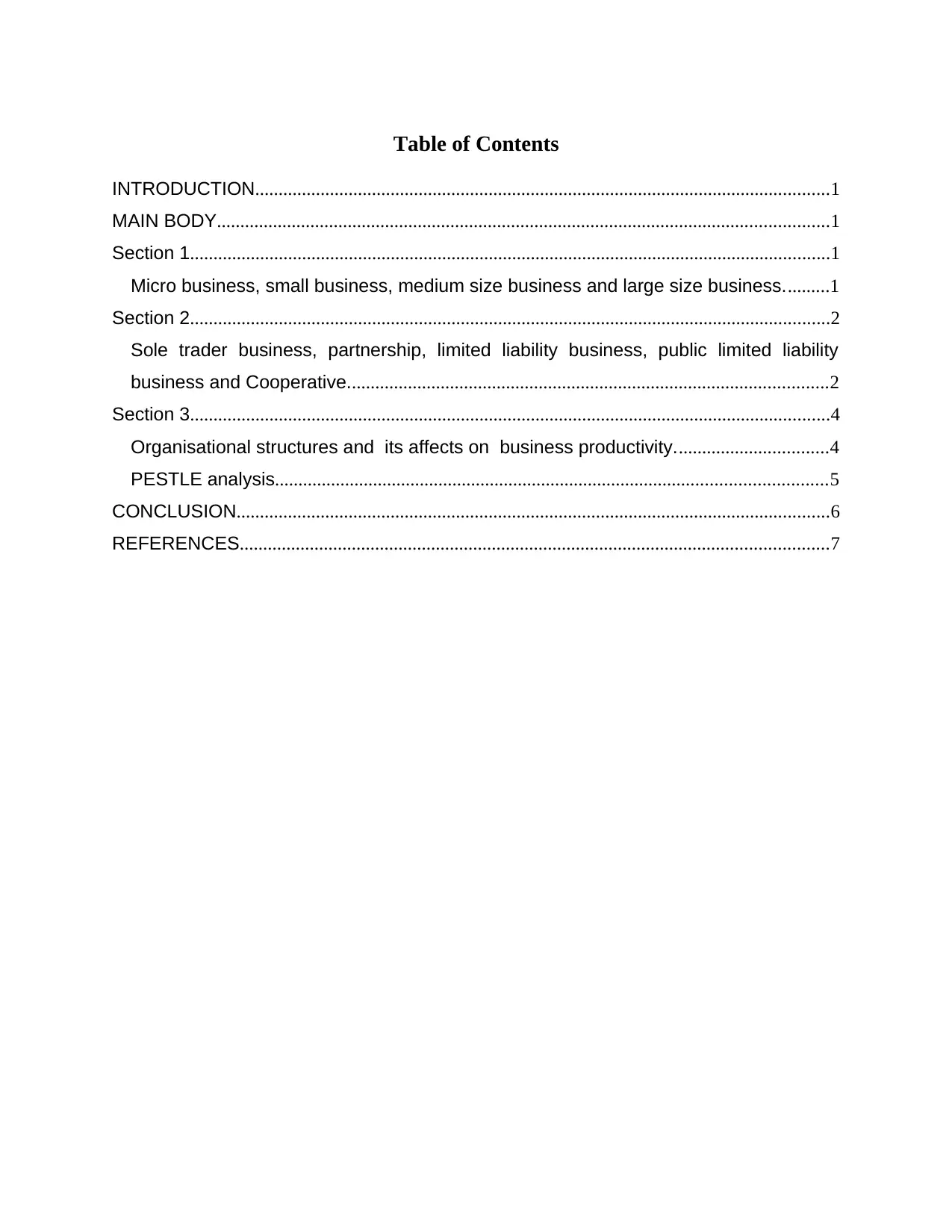
Table of Contents
INTRODUCTION...........................................................................................................................1
MAIN BODY...................................................................................................................................1
Section 1.........................................................................................................................................1
Micro business, small business, medium size business and large size business..........1
Section 2.........................................................................................................................................2
Sole trader business, partnership, limited liability business, public limited liability
business and Cooperative.......................................................................................................2
Section 3.........................................................................................................................................4
Organisational structures and its affects on business productivity.................................4
PESTLE analysis......................................................................................................................5
CONCLUSION...............................................................................................................................6
REFERENCES..............................................................................................................................7
INTRODUCTION...........................................................................................................................1
MAIN BODY...................................................................................................................................1
Section 1.........................................................................................................................................1
Micro business, small business, medium size business and large size business..........1
Section 2.........................................................................................................................................2
Sole trader business, partnership, limited liability business, public limited liability
business and Cooperative.......................................................................................................2
Section 3.........................................................................................................................................4
Organisational structures and its affects on business productivity.................................4
PESTLE analysis......................................................................................................................5
CONCLUSION...............................................................................................................................6
REFERENCES..............................................................................................................................7
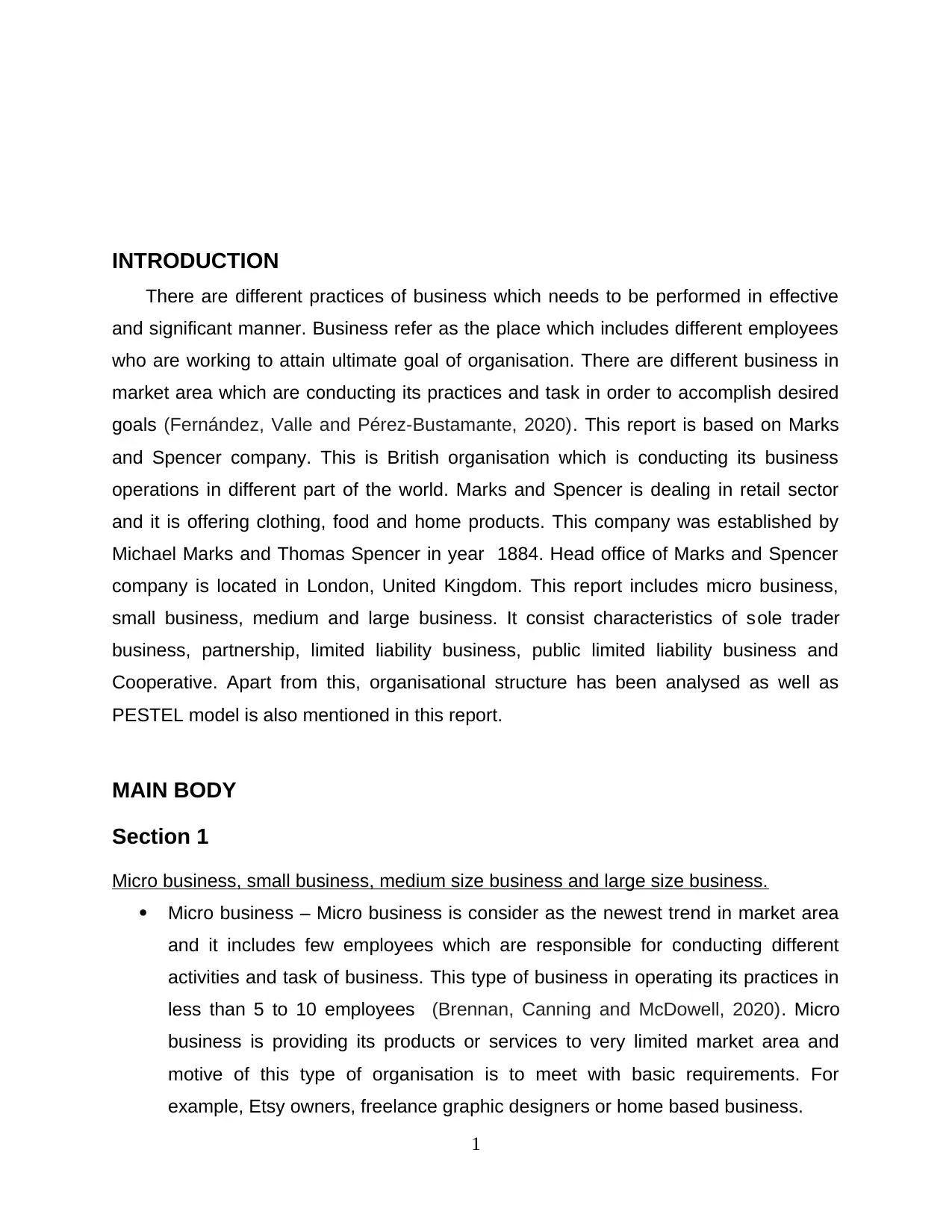
INTRODUCTION
There are different practices of business which needs to be performed in effective
and significant manner. Business refer as the place which includes different employees
who are working to attain ultimate goal of organisation. There are different business in
market area which are conducting its practices and task in order to accomplish desired
goals (Fernández, Valle and Pérez-Bustamante, 2020). This report is based on Marks
and Spencer company. This is British organisation which is conducting its business
operations in different part of the world. Marks and Spencer is dealing in retail sector
and it is offering clothing, food and home products. This company was established by
Michael Marks and Thomas Spencer in year 1884. Head office of Marks and Spencer
company is located in London, United Kingdom. This report includes micro business,
small business, medium and large business. It consist characteristics of sole trader
business, partnership, limited liability business, public limited liability business and
Cooperative. Apart from this, organisational structure has been analysed as well as
PESTEL model is also mentioned in this report.
MAIN BODY
Section 1
Micro business, small business, medium size business and large size business.
Micro business – Micro business is consider as the newest trend in market area
and it includes few employees which are responsible for conducting different
activities and task of business. This type of business in operating its practices in
less than 5 to 10 employees (Brennan, Canning and McDowell, 2020). Micro
business is providing its products or services to very limited market area and
motive of this type of organisation is to meet with basic requirements. For
example, Etsy owners, freelance graphic designers or home based business.
1
There are different practices of business which needs to be performed in effective
and significant manner. Business refer as the place which includes different employees
who are working to attain ultimate goal of organisation. There are different business in
market area which are conducting its practices and task in order to accomplish desired
goals (Fernández, Valle and Pérez-Bustamante, 2020). This report is based on Marks
and Spencer company. This is British organisation which is conducting its business
operations in different part of the world. Marks and Spencer is dealing in retail sector
and it is offering clothing, food and home products. This company was established by
Michael Marks and Thomas Spencer in year 1884. Head office of Marks and Spencer
company is located in London, United Kingdom. This report includes micro business,
small business, medium and large business. It consist characteristics of sole trader
business, partnership, limited liability business, public limited liability business and
Cooperative. Apart from this, organisational structure has been analysed as well as
PESTEL model is also mentioned in this report.
MAIN BODY
Section 1
Micro business, small business, medium size business and large size business.
Micro business – Micro business is consider as the newest trend in market area
and it includes few employees which are responsible for conducting different
activities and task of business. This type of business in operating its practices in
less than 5 to 10 employees (Brennan, Canning and McDowell, 2020). Micro
business is providing its products or services to very limited market area and
motive of this type of organisation is to meet with basic requirements. For
example, Etsy owners, freelance graphic designers or home based business.
1
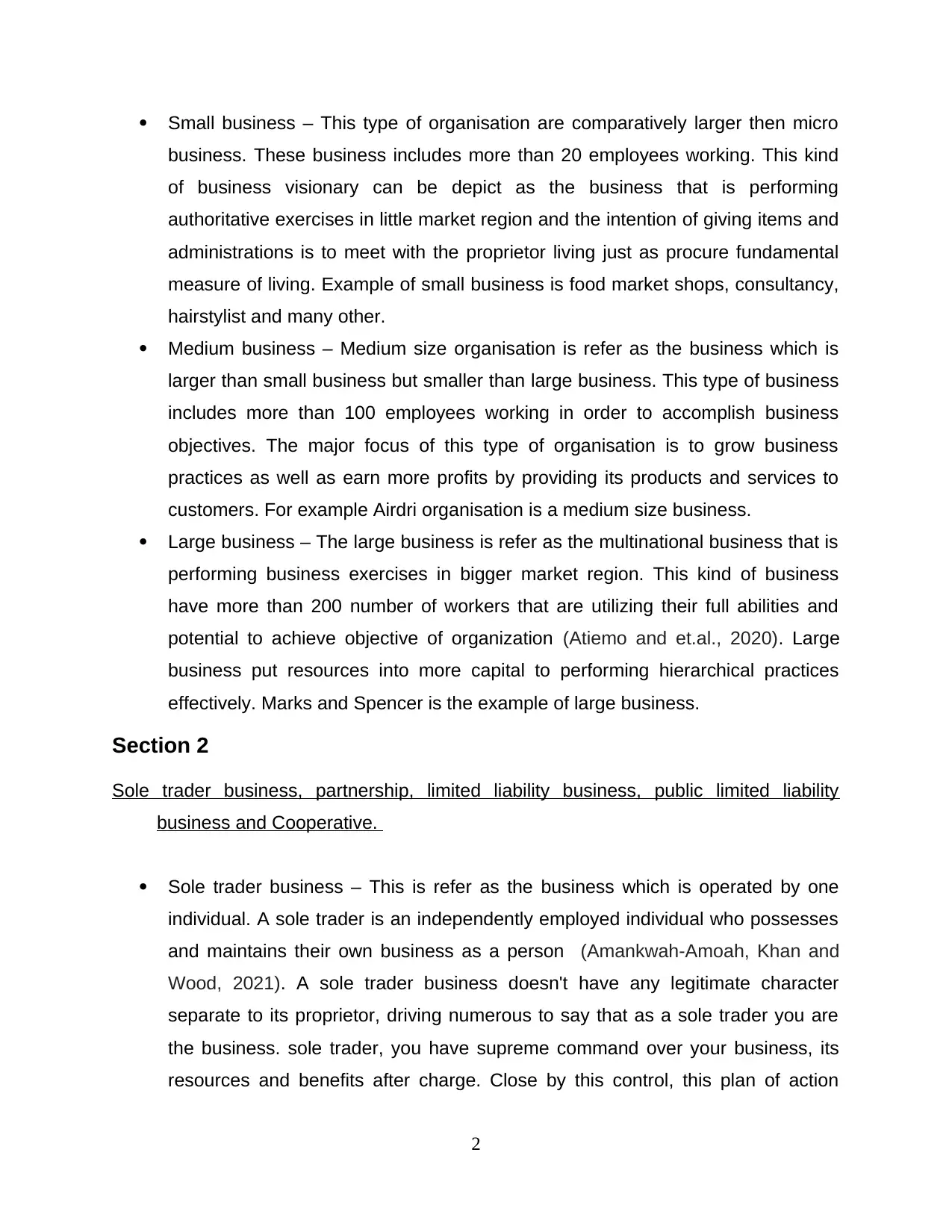
Small business – This type of organisation are comparatively larger then micro
business. These business includes more than 20 employees working. This kind
of business visionary can be depict as the business that is performing
authoritative exercises in little market region and the intention of giving items and
administrations is to meet with the proprietor living just as procure fundamental
measure of living. Example of small business is food market shops, consultancy,
hairstylist and many other.
Medium business – Medium size organisation is refer as the business which is
larger than small business but smaller than large business. This type of business
includes more than 100 employees working in order to accomplish business
objectives. The major focus of this type of organisation is to grow business
practices as well as earn more profits by providing its products and services to
customers. For example Airdri organisation is a medium size business.
Large business – The large business is refer as the multinational business that is
performing business exercises in bigger market region. This kind of business
have more than 200 number of workers that are utilizing their full abilities and
potential to achieve objective of organization (Atiemo and et.al., 2020). Large
business put resources into more capital to performing hierarchical practices
effectively. Marks and Spencer is the example of large business.
Section 2
Sole trader business, partnership, limited liability business, public limited liability
business and Cooperative.
Sole trader business – This is refer as the business which is operated by one
individual. A sole trader is an independently employed individual who possesses
and maintains their own business as a person (Amankwah-Amoah, Khan and
Wood, 2021). A sole trader business doesn't have any legitimate character
separate to its proprietor, driving numerous to say that as a sole trader you are
the business. sole trader, you have supreme command over your business, its
resources and benefits after charge. Close by this control, this plan of action
2
business. These business includes more than 20 employees working. This kind
of business visionary can be depict as the business that is performing
authoritative exercises in little market region and the intention of giving items and
administrations is to meet with the proprietor living just as procure fundamental
measure of living. Example of small business is food market shops, consultancy,
hairstylist and many other.
Medium business – Medium size organisation is refer as the business which is
larger than small business but smaller than large business. This type of business
includes more than 100 employees working in order to accomplish business
objectives. The major focus of this type of organisation is to grow business
practices as well as earn more profits by providing its products and services to
customers. For example Airdri organisation is a medium size business.
Large business – The large business is refer as the multinational business that is
performing business exercises in bigger market region. This kind of business
have more than 200 number of workers that are utilizing their full abilities and
potential to achieve objective of organization (Atiemo and et.al., 2020). Large
business put resources into more capital to performing hierarchical practices
effectively. Marks and Spencer is the example of large business.
Section 2
Sole trader business, partnership, limited liability business, public limited liability
business and Cooperative.
Sole trader business – This is refer as the business which is operated by one
individual. A sole trader is an independently employed individual who possesses
and maintains their own business as a person (Amankwah-Amoah, Khan and
Wood, 2021). A sole trader business doesn't have any legitimate character
separate to its proprietor, driving numerous to say that as a sole trader you are
the business. sole trader, you have supreme command over your business, its
resources and benefits after charge. Close by this control, this plan of action
2
Secure Best Marks with AI Grader
Need help grading? Try our AI Grader for instant feedback on your assignments.
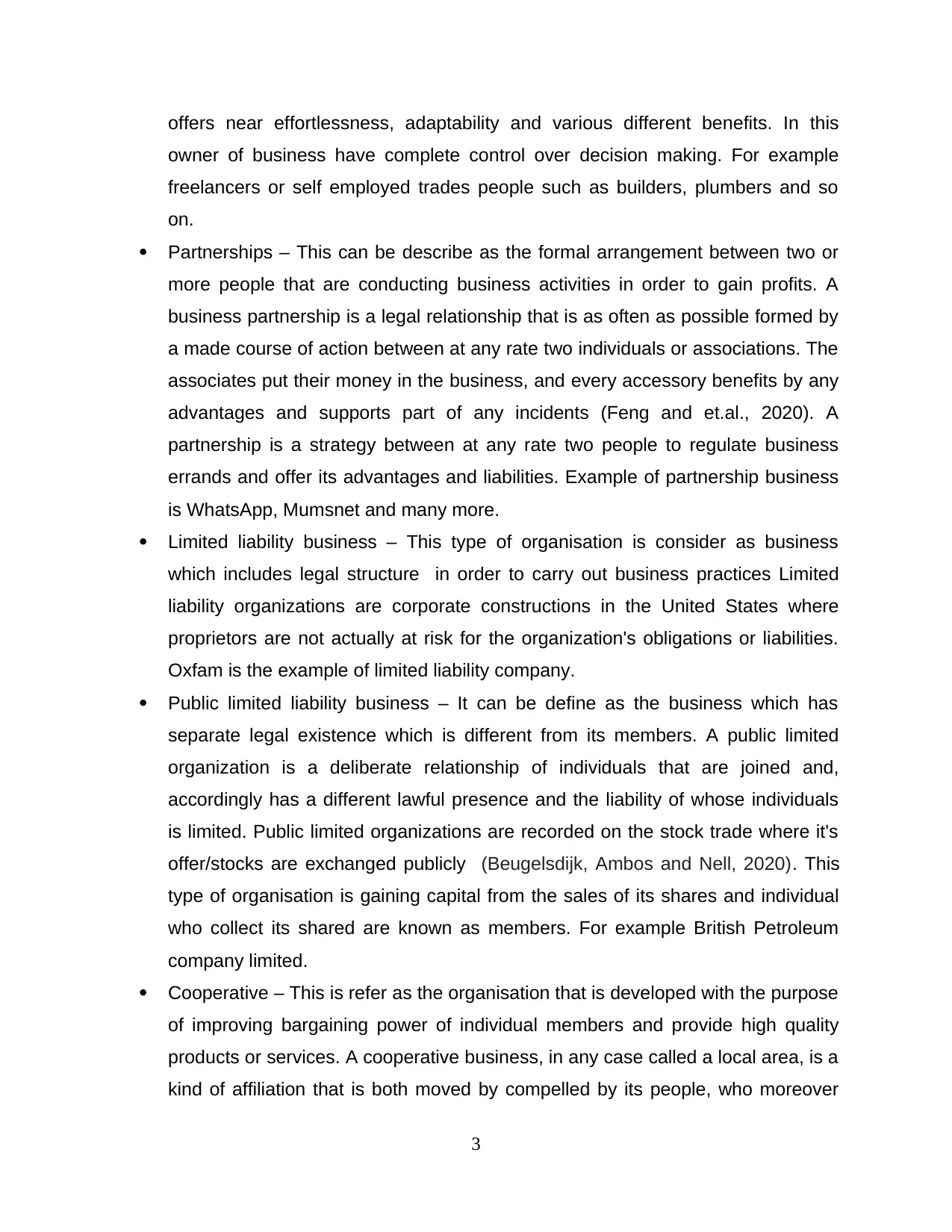
offers near effortlessness, adaptability and various different benefits. In this
owner of business have complete control over decision making. For example
freelancers or self employed trades people such as builders, plumbers and so
on.
Partnerships – This can be describe as the formal arrangement between two or
more people that are conducting business activities in order to gain profits. A
business partnership is a legal relationship that is as often as possible formed by
a made course of action between at any rate two individuals or associations. The
associates put their money in the business, and every accessory benefits by any
advantages and supports part of any incidents (Feng and et.al., 2020). A
partnership is a strategy between at any rate two people to regulate business
errands and offer its advantages and liabilities. Example of partnership business
is WhatsApp, Mumsnet and many more.
Limited liability business – This type of organisation is consider as business
which includes legal structure in order to carry out business practices Limited
liability organizations are corporate constructions in the United States where
proprietors are not actually at risk for the organization's obligations or liabilities.
Oxfam is the example of limited liability company.
Public limited liability business – It can be define as the business which has
separate legal existence which is different from its members. A public limited
organization is a deliberate relationship of individuals that are joined and,
accordingly has a different lawful presence and the liability of whose individuals
is limited. Public limited organizations are recorded on the stock trade where it's
offer/stocks are exchanged publicly (Beugelsdijk, Ambos and Nell, 2020). This
type of organisation is gaining capital from the sales of its shares and individual
who collect its shared are known as members. For example British Petroleum
company limited.
Cooperative – This is refer as the organisation that is developed with the purpose
of improving bargaining power of individual members and provide high quality
products or services. A cooperative business, in any case called a local area, is a
kind of affiliation that is both moved by compelled by its people, who moreover
3
owner of business have complete control over decision making. For example
freelancers or self employed trades people such as builders, plumbers and so
on.
Partnerships – This can be describe as the formal arrangement between two or
more people that are conducting business activities in order to gain profits. A
business partnership is a legal relationship that is as often as possible formed by
a made course of action between at any rate two individuals or associations. The
associates put their money in the business, and every accessory benefits by any
advantages and supports part of any incidents (Feng and et.al., 2020). A
partnership is a strategy between at any rate two people to regulate business
errands and offer its advantages and liabilities. Example of partnership business
is WhatsApp, Mumsnet and many more.
Limited liability business – This type of organisation is consider as business
which includes legal structure in order to carry out business practices Limited
liability organizations are corporate constructions in the United States where
proprietors are not actually at risk for the organization's obligations or liabilities.
Oxfam is the example of limited liability company.
Public limited liability business – It can be define as the business which has
separate legal existence which is different from its members. A public limited
organization is a deliberate relationship of individuals that are joined and,
accordingly has a different lawful presence and the liability of whose individuals
is limited. Public limited organizations are recorded on the stock trade where it's
offer/stocks are exchanged publicly (Beugelsdijk, Ambos and Nell, 2020). This
type of organisation is gaining capital from the sales of its shares and individual
who collect its shared are known as members. For example British Petroleum
company limited.
Cooperative – This is refer as the organisation that is developed with the purpose
of improving bargaining power of individual members and provide high quality
products or services. A cooperative business, in any case called a local area, is a
kind of affiliation that is both moved by compelled by its people, who moreover
3
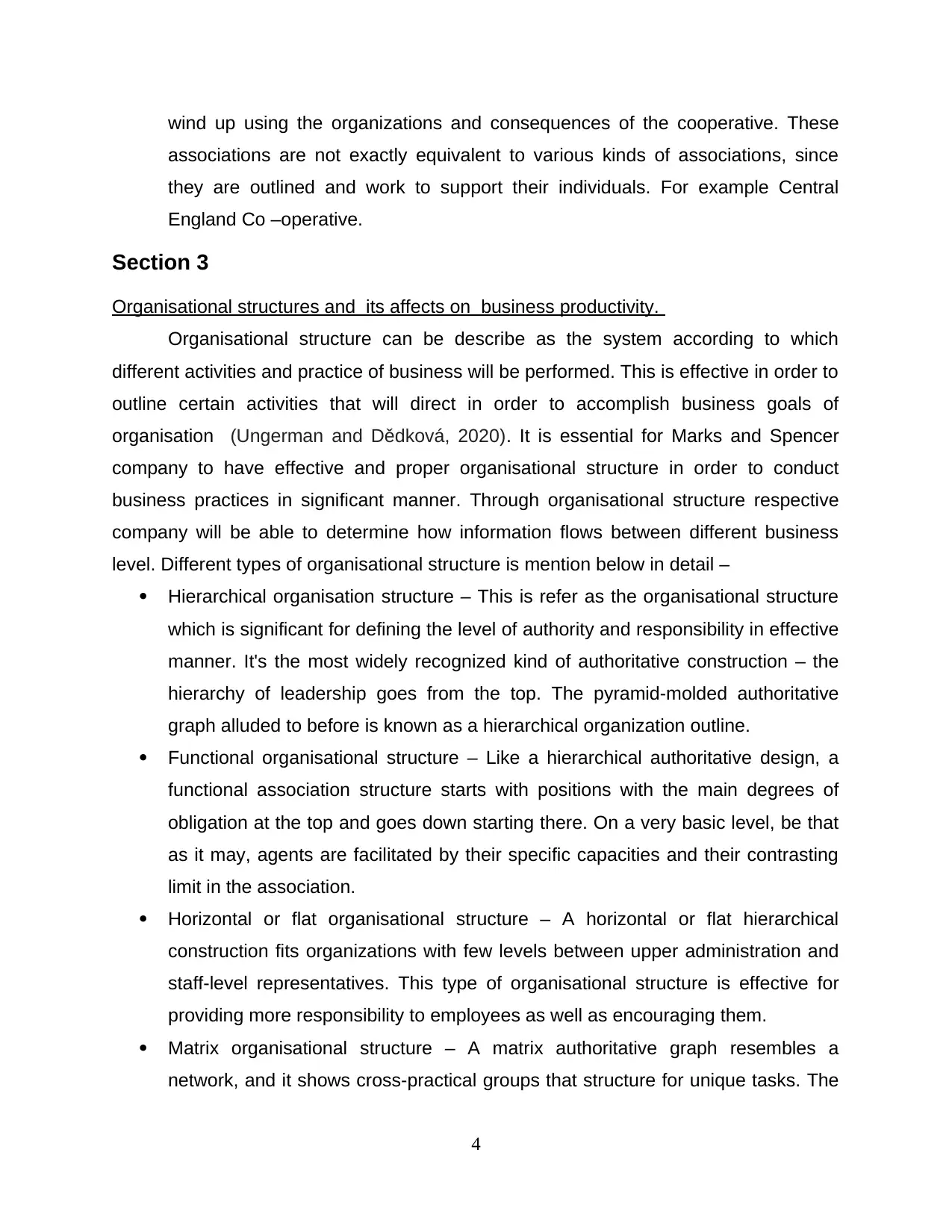
wind up using the organizations and consequences of the cooperative. These
associations are not exactly equivalent to various kinds of associations, since
they are outlined and work to support their individuals. For example Central
England Co –operative.
Section 3
Organisational structures and its affects on business productivity.
Organisational structure can be describe as the system according to which
different activities and practice of business will be performed. This is effective in order to
outline certain activities that will direct in order to accomplish business goals of
organisation (Ungerman and Dědková, 2020). It is essential for Marks and Spencer
company to have effective and proper organisational structure in order to conduct
business practices in significant manner. Through organisational structure respective
company will be able to determine how information flows between different business
level. Different types of organisational structure is mention below in detail –
Hierarchical organisation structure – This is refer as the organisational structure
which is significant for defining the level of authority and responsibility in effective
manner. It's the most widely recognized kind of authoritative construction – the
hierarchy of leadership goes from the top. The pyramid-molded authoritative
graph alluded to before is known as a hierarchical organization outline.
Functional organisational structure – Like a hierarchical authoritative design, a
functional association structure starts with positions with the main degrees of
obligation at the top and goes down starting there. On a very basic level, be that
as it may, agents are facilitated by their specific capacities and their contrasting
limit in the association.
Horizontal or flat organisational structure – A horizontal or flat hierarchical
construction fits organizations with few levels between upper administration and
staff-level representatives. This type of organisational structure is effective for
providing more responsibility to employees as well as encouraging them.
Matrix organisational structure – A matrix authoritative graph resembles a
network, and it shows cross-practical groups that structure for unique tasks. The
4
associations are not exactly equivalent to various kinds of associations, since
they are outlined and work to support their individuals. For example Central
England Co –operative.
Section 3
Organisational structures and its affects on business productivity.
Organisational structure can be describe as the system according to which
different activities and practice of business will be performed. This is effective in order to
outline certain activities that will direct in order to accomplish business goals of
organisation (Ungerman and Dědková, 2020). It is essential for Marks and Spencer
company to have effective and proper organisational structure in order to conduct
business practices in significant manner. Through organisational structure respective
company will be able to determine how information flows between different business
level. Different types of organisational structure is mention below in detail –
Hierarchical organisation structure – This is refer as the organisational structure
which is significant for defining the level of authority and responsibility in effective
manner. It's the most widely recognized kind of authoritative construction – the
hierarchy of leadership goes from the top. The pyramid-molded authoritative
graph alluded to before is known as a hierarchical organization outline.
Functional organisational structure – Like a hierarchical authoritative design, a
functional association structure starts with positions with the main degrees of
obligation at the top and goes down starting there. On a very basic level, be that
as it may, agents are facilitated by their specific capacities and their contrasting
limit in the association.
Horizontal or flat organisational structure – A horizontal or flat hierarchical
construction fits organizations with few levels between upper administration and
staff-level representatives. This type of organisational structure is effective for
providing more responsibility to employees as well as encouraging them.
Matrix organisational structure – A matrix authoritative graph resembles a
network, and it shows cross-practical groups that structure for unique tasks. The
4
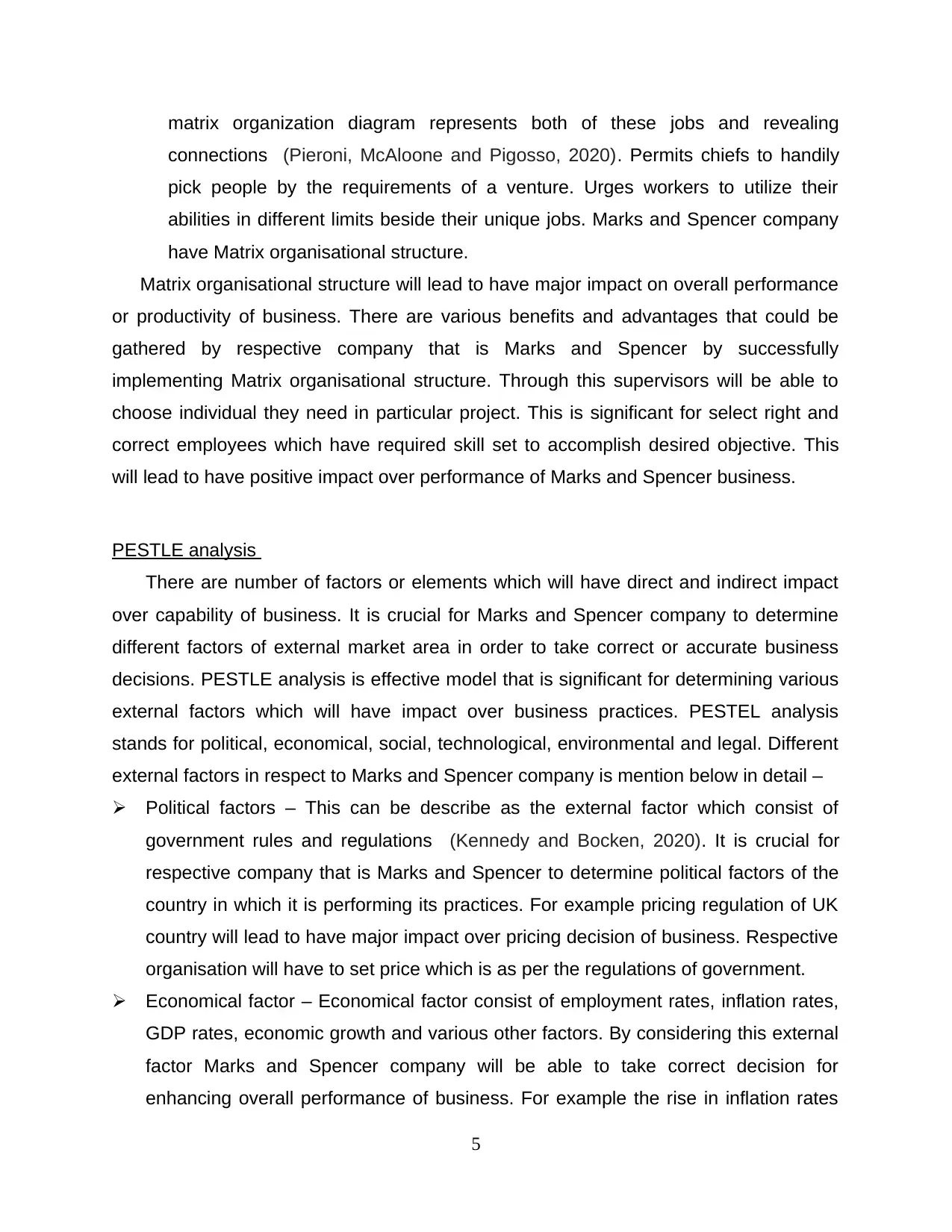
matrix organization diagram represents both of these jobs and revealing
connections (Pieroni, McAloone and Pigosso, 2020). Permits chiefs to handily
pick people by the requirements of a venture. Urges workers to utilize their
abilities in different limits beside their unique jobs. Marks and Spencer company
have Matrix organisational structure.
Matrix organisational structure will lead to have major impact on overall performance
or productivity of business. There are various benefits and advantages that could be
gathered by respective company that is Marks and Spencer by successfully
implementing Matrix organisational structure. Through this supervisors will be able to
choose individual they need in particular project. This is significant for select right and
correct employees which have required skill set to accomplish desired objective. This
will lead to have positive impact over performance of Marks and Spencer business.
PESTLE analysis
There are number of factors or elements which will have direct and indirect impact
over capability of business. It is crucial for Marks and Spencer company to determine
different factors of external market area in order to take correct or accurate business
decisions. PESTLE analysis is effective model that is significant for determining various
external factors which will have impact over business practices. PESTEL analysis
stands for political, economical, social, technological, environmental and legal. Different
external factors in respect to Marks and Spencer company is mention below in detail –
Political factors – This can be describe as the external factor which consist of
government rules and regulations (Kennedy and Bocken, 2020). It is crucial for
respective company that is Marks and Spencer to determine political factors of the
country in which it is performing its practices. For example pricing regulation of UK
country will lead to have major impact over pricing decision of business. Respective
organisation will have to set price which is as per the regulations of government.
Economical factor – Economical factor consist of employment rates, inflation rates,
GDP rates, economic growth and various other factors. By considering this external
factor Marks and Spencer company will be able to take correct decision for
enhancing overall performance of business. For example the rise in inflation rates
5
connections (Pieroni, McAloone and Pigosso, 2020). Permits chiefs to handily
pick people by the requirements of a venture. Urges workers to utilize their
abilities in different limits beside their unique jobs. Marks and Spencer company
have Matrix organisational structure.
Matrix organisational structure will lead to have major impact on overall performance
or productivity of business. There are various benefits and advantages that could be
gathered by respective company that is Marks and Spencer by successfully
implementing Matrix organisational structure. Through this supervisors will be able to
choose individual they need in particular project. This is significant for select right and
correct employees which have required skill set to accomplish desired objective. This
will lead to have positive impact over performance of Marks and Spencer business.
PESTLE analysis
There are number of factors or elements which will have direct and indirect impact
over capability of business. It is crucial for Marks and Spencer company to determine
different factors of external market area in order to take correct or accurate business
decisions. PESTLE analysis is effective model that is significant for determining various
external factors which will have impact over business practices. PESTEL analysis
stands for political, economical, social, technological, environmental and legal. Different
external factors in respect to Marks and Spencer company is mention below in detail –
Political factors – This can be describe as the external factor which consist of
government rules and regulations (Kennedy and Bocken, 2020). It is crucial for
respective company that is Marks and Spencer to determine political factors of the
country in which it is performing its practices. For example pricing regulation of UK
country will lead to have major impact over pricing decision of business. Respective
organisation will have to set price which is as per the regulations of government.
Economical factor – Economical factor consist of employment rates, inflation rates,
GDP rates, economic growth and various other factors. By considering this external
factor Marks and Spencer company will be able to take correct decision for
enhancing overall performance of business. For example the rise in inflation rates
5
Paraphrase This Document
Need a fresh take? Get an instant paraphrase of this document with our AI Paraphraser
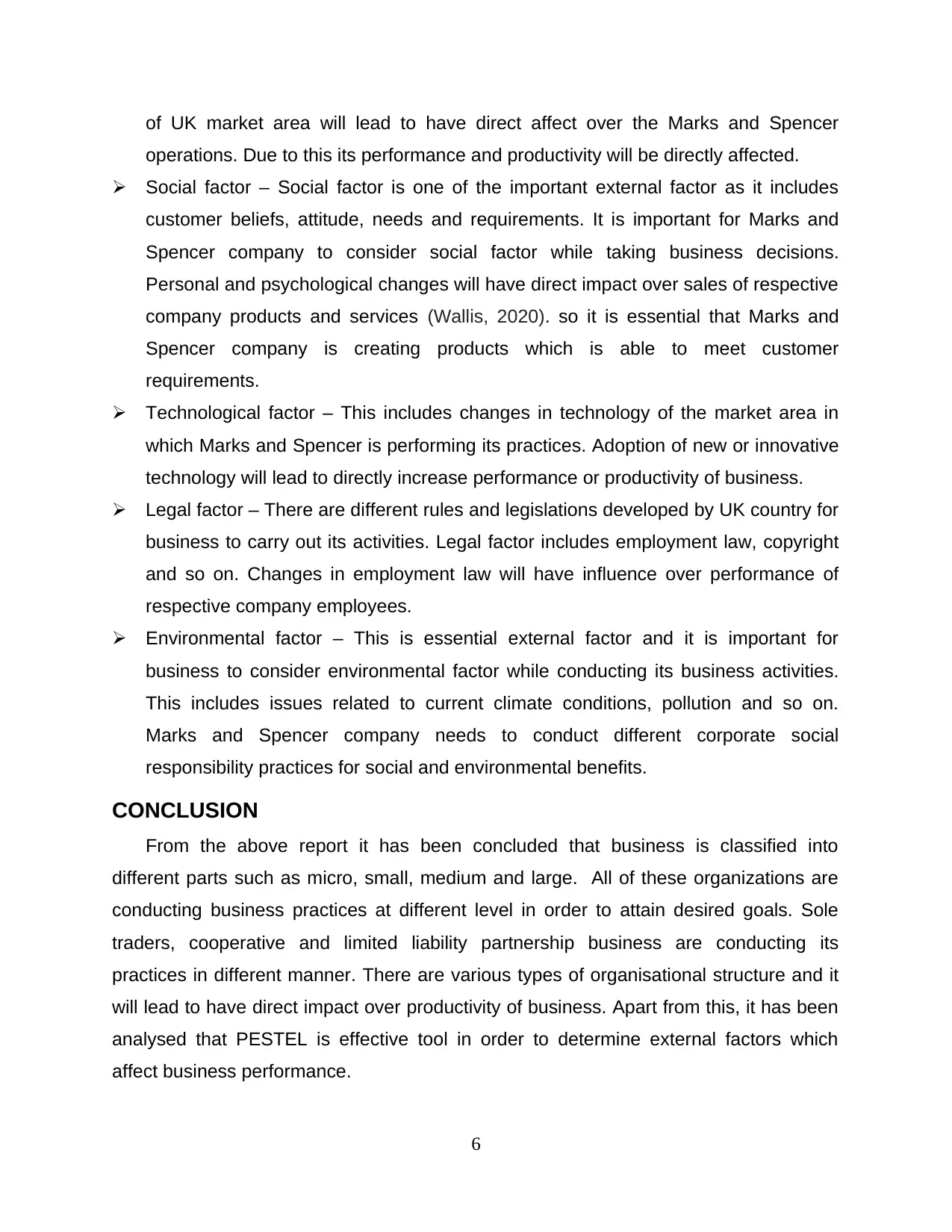
of UK market area will lead to have direct affect over the Marks and Spencer
operations. Due to this its performance and productivity will be directly affected.
Social factor – Social factor is one of the important external factor as it includes
customer beliefs, attitude, needs and requirements. It is important for Marks and
Spencer company to consider social factor while taking business decisions.
Personal and psychological changes will have direct impact over sales of respective
company products and services (Wallis, 2020). so it is essential that Marks and
Spencer company is creating products which is able to meet customer
requirements.
Technological factor – This includes changes in technology of the market area in
which Marks and Spencer is performing its practices. Adoption of new or innovative
technology will lead to directly increase performance or productivity of business.
Legal factor – There are different rules and legislations developed by UK country for
business to carry out its activities. Legal factor includes employment law, copyright
and so on. Changes in employment law will have influence over performance of
respective company employees.
Environmental factor – This is essential external factor and it is important for
business to consider environmental factor while conducting its business activities.
This includes issues related to current climate conditions, pollution and so on.
Marks and Spencer company needs to conduct different corporate social
responsibility practices for social and environmental benefits.
CONCLUSION
From the above report it has been concluded that business is classified into
different parts such as micro, small, medium and large. All of these organizations are
conducting business practices at different level in order to attain desired goals. Sole
traders, cooperative and limited liability partnership business are conducting its
practices in different manner. There are various types of organisational structure and it
will lead to have direct impact over productivity of business. Apart from this, it has been
analysed that PESTEL is effective tool in order to determine external factors which
affect business performance.
6
operations. Due to this its performance and productivity will be directly affected.
Social factor – Social factor is one of the important external factor as it includes
customer beliefs, attitude, needs and requirements. It is important for Marks and
Spencer company to consider social factor while taking business decisions.
Personal and psychological changes will have direct impact over sales of respective
company products and services (Wallis, 2020). so it is essential that Marks and
Spencer company is creating products which is able to meet customer
requirements.
Technological factor – This includes changes in technology of the market area in
which Marks and Spencer is performing its practices. Adoption of new or innovative
technology will lead to directly increase performance or productivity of business.
Legal factor – There are different rules and legislations developed by UK country for
business to carry out its activities. Legal factor includes employment law, copyright
and so on. Changes in employment law will have influence over performance of
respective company employees.
Environmental factor – This is essential external factor and it is important for
business to consider environmental factor while conducting its business activities.
This includes issues related to current climate conditions, pollution and so on.
Marks and Spencer company needs to conduct different corporate social
responsibility practices for social and environmental benefits.
CONCLUSION
From the above report it has been concluded that business is classified into
different parts such as micro, small, medium and large. All of these organizations are
conducting business practices at different level in order to attain desired goals. Sole
traders, cooperative and limited liability partnership business are conducting its
practices in different manner. There are various types of organisational structure and it
will lead to have direct impact over productivity of business. Apart from this, it has been
analysed that PESTEL is effective tool in order to determine external factors which
affect business performance.
6
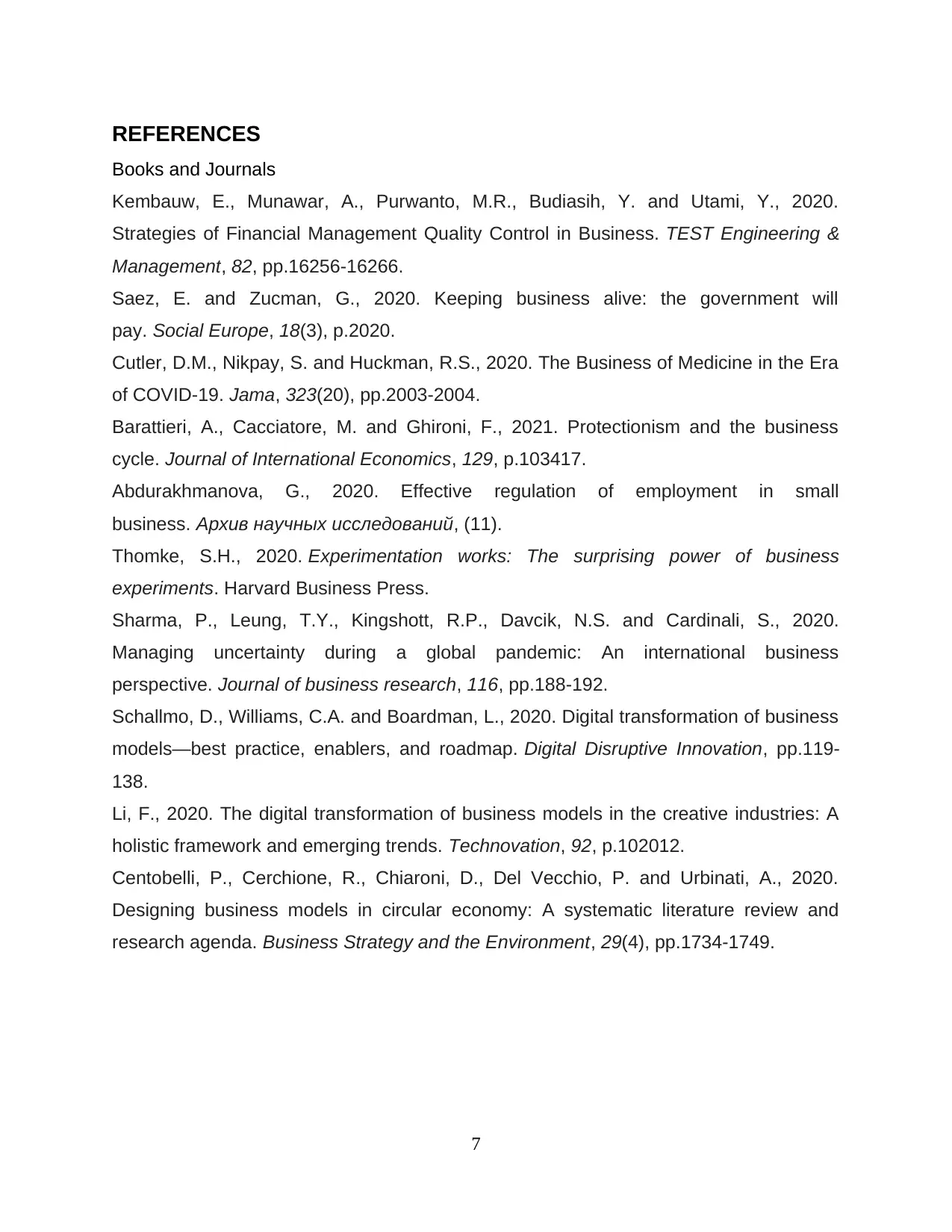
REFERENCES
Books and Journals
Kembauw, E., Munawar, A., Purwanto, M.R., Budiasih, Y. and Utami, Y., 2020.
Strategies of Financial Management Quality Control in Business. TEST Engineering &
Management, 82, pp.16256-16266.
Saez, E. and Zucman, G., 2020. Keeping business alive: the government will
pay. Social Europe, 18(3), p.2020.
Cutler, D.M., Nikpay, S. and Huckman, R.S., 2020. The Business of Medicine in the Era
of COVID-19. Jama, 323(20), pp.2003-2004.
Barattieri, A., Cacciatore, M. and Ghironi, F., 2021. Protectionism and the business
cycle. Journal of International Economics, 129, p.103417.
Abdurakhmanova, G., 2020. Effective regulation of employment in small
business. Архив научных исследований, (11).
Thomke, S.H., 2020. Experimentation works: The surprising power of business
experiments. Harvard Business Press.
Sharma, P., Leung, T.Y., Kingshott, R.P., Davcik, N.S. and Cardinali, S., 2020.
Managing uncertainty during a global pandemic: An international business
perspective. Journal of business research, 116, pp.188-192.
Schallmo, D., Williams, C.A. and Boardman, L., 2020. Digital transformation of business
models—best practice, enablers, and roadmap. Digital Disruptive Innovation, pp.119-
138.
Li, F., 2020. The digital transformation of business models in the creative industries: A
holistic framework and emerging trends. Technovation, 92, p.102012.
Centobelli, P., Cerchione, R., Chiaroni, D., Del Vecchio, P. and Urbinati, A., 2020.
Designing business models in circular economy: A systematic literature review and
research agenda. Business Strategy and the Environment, 29(4), pp.1734-1749.
7
Books and Journals
Kembauw, E., Munawar, A., Purwanto, M.R., Budiasih, Y. and Utami, Y., 2020.
Strategies of Financial Management Quality Control in Business. TEST Engineering &
Management, 82, pp.16256-16266.
Saez, E. and Zucman, G., 2020. Keeping business alive: the government will
pay. Social Europe, 18(3), p.2020.
Cutler, D.M., Nikpay, S. and Huckman, R.S., 2020. The Business of Medicine in the Era
of COVID-19. Jama, 323(20), pp.2003-2004.
Barattieri, A., Cacciatore, M. and Ghironi, F., 2021. Protectionism and the business
cycle. Journal of International Economics, 129, p.103417.
Abdurakhmanova, G., 2020. Effective regulation of employment in small
business. Архив научных исследований, (11).
Thomke, S.H., 2020. Experimentation works: The surprising power of business
experiments. Harvard Business Press.
Sharma, P., Leung, T.Y., Kingshott, R.P., Davcik, N.S. and Cardinali, S., 2020.
Managing uncertainty during a global pandemic: An international business
perspective. Journal of business research, 116, pp.188-192.
Schallmo, D., Williams, C.A. and Boardman, L., 2020. Digital transformation of business
models—best practice, enablers, and roadmap. Digital Disruptive Innovation, pp.119-
138.
Li, F., 2020. The digital transformation of business models in the creative industries: A
holistic framework and emerging trends. Technovation, 92, p.102012.
Centobelli, P., Cerchione, R., Chiaroni, D., Del Vecchio, P. and Urbinati, A., 2020.
Designing business models in circular economy: A systematic literature review and
research agenda. Business Strategy and the Environment, 29(4), pp.1734-1749.
7
1 out of 9
Related Documents
Your All-in-One AI-Powered Toolkit for Academic Success.
+13062052269
info@desklib.com
Available 24*7 on WhatsApp / Email
![[object Object]](/_next/static/media/star-bottom.7253800d.svg)
Unlock your academic potential
© 2024 | Zucol Services PVT LTD | All rights reserved.





